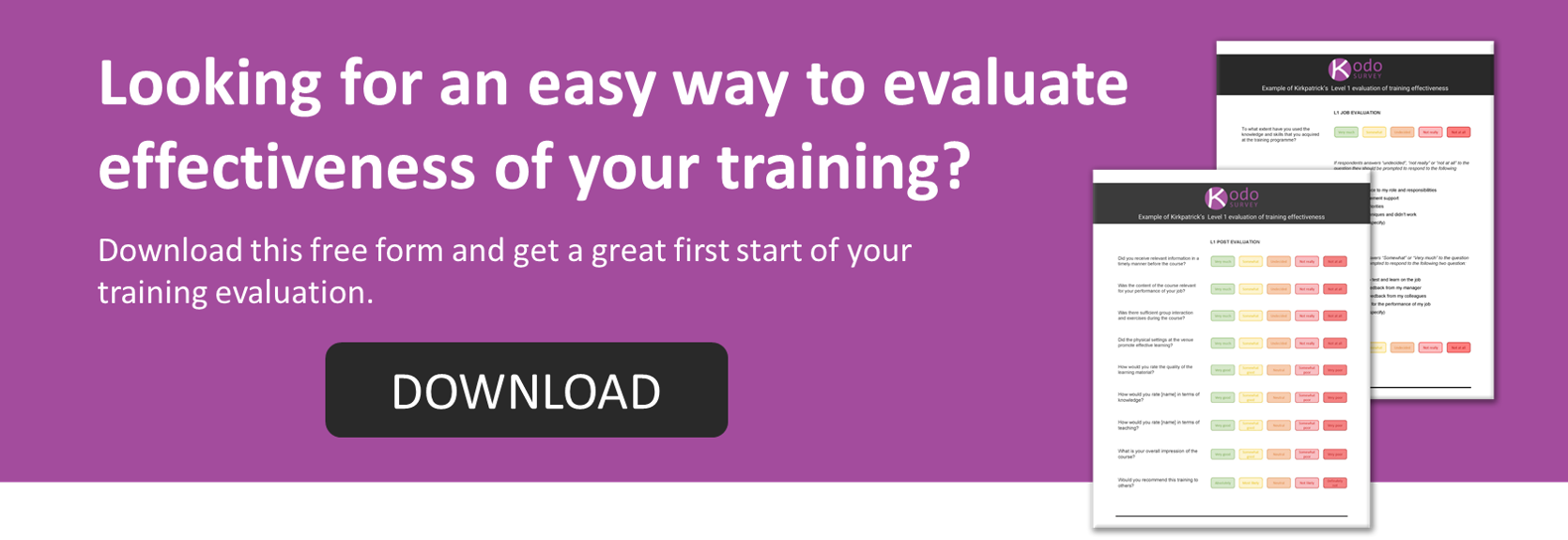
If you’re in the training business, you’ll know that continuing education is an urgent priority for all industries due to rapidly evolving technologies and globalization. Knowledge and skills training is essential for people at all stages of their careers to avoid being left behind. Surveys can help boost the effectiveness of training and in this post, we’ll share examples and types of pre-training survey questions that you should know.
Why use pre-training surveys?
All trainees share the same goal: to learn new knowledge and skills and put what they learn into practice as soon as possible. They want to see progress and improvement, or they’ll soon lose interest. A pre-training survey can help ensure that the training you offer meets these expectations.
Pre-training surveys can help in a number of ways, such as:
- Telling you more about the participants’ expectations
- Highlighting your participants’ abilities and backgrounds
- Focusing in on their needs and preferences
Pre-training surveys help you gather data that can inform how you run the training, how it’s delivered and what content it covers. The results from the survey will help you make changes or improvements that maximize the results for the participants. Overall, a well-written survey can help boost the effectiveness of your training.
Surveys vs Questionnaires: What’s the difference?
Surveys and questionnaires aren’t synonymous, despite most people using the terms interchangeably. Both approaches are a way of gathering data, but it’s what you do with the data that counts.
A questionnaire is a data collection tool that helps you collect and store data, without analyzing it while a survey is a way of gathering data for forecasting or analysis. A large portion of a survey may be a questionnaire, but the survey data will be used for statistical analysis later.
While both surveys and questionnaires can be helpful for training professionals, statistical analysis of survey data will give you greater insights into the effectiveness of your training.
You can:
- Apply the feedback to training programs
- Target specific knowledge or skills
- Plan focused training to meet needs that you identify
How to use pre-training surveys to boost training effectiveness
A pre-training survey is an important part of running any effective training program. A well-written survey can help in a number of ways.
Pre-training surveys can boost the effectiveness of your training by:
- Helping you identify what training to offer
- Giving you a snapshot of the respondents’ knowledge and understanding
- Modifying course content to meet the participants’ levels
To gain these insights, you’ll need to ask the right questions, in the right way, and then use the data in conjunction with models for evaluating training effectiveness such as the Kirkpatrick model.

Pre-training survey question types
There are only two types of survey questions: objective and subjective. Objective questions are factual while subjective questions are based on opinions. However, there are many types of question responses to choose from. These include:
- Single-choice and multiple choice questions
- Picture choice questions
- Likert scale questions
- Closed-ended questions
- Open-ended questions
Pre-training survey question examples
In this guide, we’ll give an overview of each of these types of question responses and offer some examples of each.
Single-choice and multiple-choice questions
Single-choice and multiple-choice questions are one of the most commonly used types of pre-training survey question. Survey respondents find them easy to understand and easy to answer as they don’t have to rely on their memory or make complex calculations.
For example, if your training will focus on the GROW coaching model (Goal – Reality – Options – Will) you may want to ask trainees about their knowledge of this model. A simple question would be: “What does GROW stand for?”. Survey respondents would have to choose one out of four possible answers.
Most people would refer to this as a multiple choice question as respondents are being asked to select one response from four possible options. Here at Kodo Survey, we refer to this as a single-choice question as we are asking respondents to make one choice. A multiple-choice question would look like this:
“What does GROW stand for”
- Great
- Grow
- Really
- Reality
- Options
- Only
- Will
- Would
In this question, we are asking the respondents to select all the answers that apply, instead of just one.
Picture choice questions
Picture choice questions are a visual, engaging and interactive version of multiple choice questions. Instead of providing written options, you provide images instead. As images can be more engaging than words, picture choice questions can help increase survey response rates.
Example: Which of the following programs do you prefer for word processing?
For the answers, you could have a choice of MS Word, Google Docs, LibreOffice and Apache OpenOffice. The respondents would choose the picture that represents their preferred choice.
Here at Kodo Survey, we offer a different way to include images and video clips in questions. You can use an image or video in the place of the written question and then ask a single-choice or multiple-choice question underneath.
For example, a pre-training survey for a word processing training course may want to find the trainee’s level of knowledge. You could show a screenshot of MS Word and label four tabs A, B, C, and D. Underneath the image, you can ask a single-choice question such as: “To Insert a table, which tab would you click?”. Respondents would indicate the correct tab to demonstrate their understanding of that function in MS Word.
Likert scale questions
Likert scale questions help you find out what respondents think about certain things. They are usually given with a 5-point scale and can provide a useful alternative to single-choice and multiple-choice questions.
For instance, if you are conducting a pre-training survey for a workplace safety course, you may ask respondents to use a Likert 5-scale to measure their attitude towards safety procedures. An objective question would be: “It is highly important to complete a daily safety check of your working area.” Respondents would choose a number between 1 and 5 to indicate their attitude towards daily safety checks.
Closed-ended questions
Closed-ended questions have a definite right or wrong answer and are therefore ideal for asking objective, factual questions.
Examples of closed-ended pre-training survey questions:
Check the best description of the size of your company:
- 1 -10 employees
- 11-99 employees
- 100-500 employees
- more than 500 employees
Check the best description of the area you work:
- Rural (under 20,000)
- Suburban
- Small town/city (over 20,000)
- large metropolitan (over 100,000)
Check the age bracket you fit into
- 20-30
- 31-40
- 41-50
- 51-60
- 61-70
- 71+
Open-ended questions
All good pre-training surveys include some open-ended questions with adequate space provided for written responses. This type of question gives you valuable information but the results can take longer to process.
Some examples of open-ended questions include:
- What expectations do you have for this training program?
- What topics would you like to learn more about during training?
- Which skills would you like to improve upon during this training?
Open-ended questions can be marked as optional, or they may be part of a hybrid open/closed-ended question. For instance, you could ask survey-takers to check the types of skills they want to improve and list various options, such as ‘Leadership skills, management skills, customer service, technology skills.’ You could then leave some space for ‘Other skills’ and ask respondents to suggest skills that they would like to see.

Examples of pre-training survey questions
If you’re looking for examples to training survey questions to ask, we’ve got you. Here are our suggestions for the best pre-training survey questions to include, organized according to categories.
Questions that measure knowledge
The purpose of a pre-training survey is to establish what the participants already know. This will inform the planning and help you or the course instructor decide what type of content and materials to offer. Instead of asking people to evaluate their level of knowledge, a good way to measure this is through single-choice and multiple-choice questions. Knowledge questions must be defined according to the taxonomy level of the learning objective that it is supposed to measure.
For example, if you are writing a pre-training survey question for a performance management course, you might ask: “What does SMART stand for?”
With four possible answers provided in a single-choice question, this lets you see how much the respondents understand about SMART and whether they can recall what it means.
One tip is to always make sure that the alternatives look equally plausible to the ‘untrained eye’. This reduces the likelihood that respondents can simply guess the correct answer.
Questions that measure attitude
The best way to measure respondents’ attitudes is with Likert 5-scale questions. For instance, if you are writing pre-training survey questions for a coaching course, you might like to measure the respondents’ attitudes to allowing silence during coaching conversations.
A good Likert 5-scale question to ask would be:
“It’s very important to allow silence in coaching conversations.”
The respondents can choose a number from 1 to 5 to indicate their response. One issue to be aware of with attitude questions using Likert 5-scale is that respondents tend to score themselves quite highly and can create a cap-effect on the results.
To avoid this, you can push the results down by adding extreme words like ‘very’, ‘absolutely’, and ‘extremely’. This makes it less likely that respondents will score themselves as four or five.
For instance, you could ask “It is extremely important to allow silence in coaching conversations”. This would lower the results and avoid a cap-effect.
Questions that measure intention
Respondents’ intentions can be measured with Likert 5-scale questions. The best approach is to use a critical incident to gauge the respondents’ reaction. A critical incident is a situation that makes a positive or negative contribution to the respondent’s key job results. For example, questions that measure intention could look like:
“I intend to spend more of my time taking notes during meetings.”
You could also ask: “How likely is it that you will (critical behavior) if you are facing a problem at work?
Intention can also be measured with single-choice and multiple-choice questions.
Questions that measure behavior
Behavior can be measured by critical incident questions with open-ended responses. Here are two examples:
1. Imagine the following scenario: Your sales team hasn’t met its sales budget for the last quarter. Your manager has asked you to investigate. You find that a team member is struggling with one of their key responsibilities. What do you do?
2. Imagine the following scenario: One of your sales representatives adjusted the prices for a customer without running it by you first. How would you respond?
Questions that measure expectations
One of the main goals of any training course is to meet the needs and expectations of the trainees. Including a series of open-ended questions can help you gain valuable insights into the types of training the survey-takers are expecting.
Some examples of open-ended questions you can ask include:
- What expectations do you have for this course or program?
- Which skills do you hope to improve by coming on this course?
- What topics would you like to focus on during training?
These open-ended questions can help you manage learners’ expectations and meet their needs during the course.
Closing thoughts
You could have the best pre-training survey questions in the world, but if your response rates are low, you won’t get the data you need. Before you start writing your own pre-training survey questions, here are some tips about how to get more people to complete your pre-training survey.
1. Be casual
Good pre-training survey questions will be designed to target very specific data. But don’t scare away survey takers by being overly stuffy or technical. Write in a casual and conversational way to get the best response rates.
2. Be Varied
Also, choose a varied approach with some picture choices to keep things visual and interactive and some open-ended questions with space for people to provide unstructured feedback.
3. Be concise
Avoid wordy, vague or ambiguous questions. Phrase them as simply as possible, using as few words as you can. This will greatly help your response rates.
To find out more, download our white paper, Determining and optimizing the impact of your training and development, or book a meeting with one of our experts.
Related Posts
